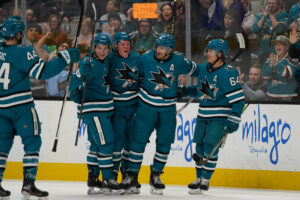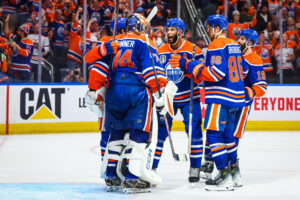Okay, so the Vancouver Canucks didn’t reach the playoffs, even with their expensive veteran signings. The injury bug bit again, especially on their defence. It’s something of a recurring theme of the Jim Benning tenure, which can be an excuse (see also: Year Five). It’s also damning evidence that the team is too shallow to resist injuries to their top players. Alexander Edler was far and away the Canucks’ best offensive defenceman, yet again. In only 56 games he scored 34 points, 11 more than Troy Stecher despite the latter’s 78 games. But help was coming – and on a few fronts.
Jim Benning Tenure
Quinn Hughes snuck into the last few games of the 2018-19 season and was electrifying. He not only scored three points in five games, paired with Luke Schenn, but showed a level of control rarely seen by Canucks fans. Of course, at 5’10” a defenceman had better be able to move his feet, and a full NHL season awaited him. Those five games were a fine start but a small sample size. Hughes wasn’t alone as a pivotal rookie that year. Thatcher Demko played well enough for the team to move Anders Nilsson and was clearly the choice to back up Jacob Markstrom. Then, of course, there was Elias Pettersson.
Pettersson’s 66 points in 71 games earned him the Calder Trophy, something barely missed by Brock Boeser the previous season. The skinny, used-to-be-a-winger started the year with 17 points in his first 11 games, galvanizing the fanbase and serving notice to the league. And he was indirectly involved in another questionable signing from Jim Benning…
Year Six – 2019-20
Hard as it is to believe, there was more than one story in the 2019-20 season. We aren’t going to rehash the sudden halt – that’s covered everywhere – but this was a big year on the ice as well. The Canucks returned to the Stanley Cup Playoffs for just the second time in the Jim Benning tenure. Any questions about Pettersson or Hughes being able to handle that second season were extinguished. Markstrom’s excellent playoffs were somehow overshadowed by Demko’s jaw-dropping .985 save percentage over four games. Bo Horvat‘s ten goals in 17 games burnished the new letter on his jersey.
The run ultimately fell short, but the regular season had plenty to be happy about as well. Adam Gaudette and Jake Virtanen provided capable secondary scoring. Tanner Pearson continued his brilliant run since the Erik Gudbranson trade. Chris Tanev played a full season (barely). Just sweep the memory of the Canucks falling out of the playoff race by the time the season halted, but do wish Benning remembered it.
[pickup_prop id=”4471″]
Free Agents
This was a big year for a big weakness in the Jim Benning tenure. The fans needed concrete results instead of piecemeal point gains. The quick turnaround had crashed, and patience was at an all-time low, especially with appetites whetted by the young talent.
The Forwards
As good as Pettersson was, one incident early in the year coloured the entire 2018-19 season. With little response from the team after he was thrown to the ice by Mike Matheson, fans wanted “protection” for their star. It was a recurring theme through the year, coming up again after an accidental tangle with the Montreal Canadiens‘ Jesperi Kotkaniemi. Bringing in someone who would react most emphatically to any attempt to intimidate Pettersson was complicated by finding who was also skilled enough to play on the top line with him and Brock Boeser. Enter Micheal Ferland on a four-year, $14 million deal.
Talks dragged between the Canucks and arguably the best shooter on the team, right until mid-September. There was no doubting the chemistry Boeser and Pettersson had in 2018-19, and on a team with few scoring threats, they needed him. Everyone knew it. Self-inflicted cap trouble made any deal a challenge, but finally a three-year contract was agreed upon. It was heavily back-loaded, giving the soon-to-be free agent a $7.5 million base salary in the final year. It brought the cap hit down, but gave him a heck of a starting point for the next round of negotiations.
The Blue Line
The perpetual issue of the Jim Benning tenure was a paper-thin defence. This encouraged the team to re-sign stalwart Edler for another two years at $6 million per. It was a million-dollar raise, but Edler had just finished his best offensive year at age 32 and was still the Canucks best defenceman. Not wanting to be exposed in the upcoming expansion draft, he also got a no-move clause. Still, the relatively short term was a safe bet for a team that needed him.
Winning the bidding war for Tyler Myers was a different deal entirely, and for a very different player. What they got for that price was an occasionally nasty giant who is an excellent skater. He can get some points, but gives up chances by the bucket as well. A lot of numbers hit the rumour mill – up to six years at seven or even eight million per, for scare quotes. There was actually a sigh of relief when the numbers were five years and $30 million. Almost as a countermeasure, the Canucks also signed Jordie Benn. Benn was sold as much more of a defensive defenceman, but with a sneaky bit of scoring as well. His 2 x $2 million deal looked… well, not like a bargain, but certainly better.
The Trades
Two BIG deals happened this season. The first didn’t quite satisfy fans who were clamouring for Benning to “weaponize cap space” but came close. J.T. Miller was snagged from the Tampa Bay Lightning for a first, a third, and an unused goaltender. The condition was that there would be no retained salary, which the Canucks could work with. There was certainly risk to go with the deal: Miller was a maybe-50-point winger signed for four more years at over $5 million a year. If this didn’t work, it would be an expensive lesson. It also pushed Sven Baertschi into the minors. The reliable-when-healthy scorer didn’t generate any interest around the league, and his contract just couldn’t stay. Harder-playing forwards were needed on the front lines, and Baertschi didn’t fit anymore.
Later in the year, with Boeser injured and the playoffs at risk of slipping away, the other big deal was made. Tyler Toffoli was brought in at a premium because of ownership’s – and Benning’s – fears of missing the playoffs yet again. He wasn’t cheap, and given the now-perpetual cap crunch he might not stay, but in their eyes, the risk was worth it. And indeed, Toffoli proved his value immediately with ten points in just ten games before the season’s pause. He couldn’t keep that up in the playoff bubble but still played well with four points in seven games.
The Draft
Vancouver had slipped a total of six draft positions in the previous three lotteries, and the 2019 year was no different. It’s a bit less traumatic to move from 9th to 10th, though, and Vasili Podkolzin was still available. Teams passed the talented Russian by because of his contract situation in Russia, but the team was happy to call his (someone’s?) name. Getting Nils Hoglander was either a mistake on the part of the other 30 teams or a catch by Vancouver. In either case, it’s not common to have a team’s second-round pick play in the NHL before their first. The rest of the draft is all potential, of course. And everyone’s selections look good one year later. Time will tell, there.
[pickup_prop id=”4253″]
The Verdict, 2019-20
A playoff appearance for the first time in five years would be worth more for the owners any other season. For the fans, it was a fun ride, but not one they could really take part in. Benning’s desperation to make the playoffs – exemplified in the Toffoli deal – may have cost the team in the near future. But for now? The Canucks not only won a playoff round, they (kind of) won another and pushed a much better team to the breaking point. It was an excellent distraction from the ongoing pandemic, and the NHL somehow pulled it off. What next year would look like, no one knew. But Canucks fans were newly eager to find out. It’s hard not to call this year a win for Benning, but right when their young talent showed they were ready, the piper was waiting to be paid.
Year Five is here.
Main Photo:
Embed from Getty Images






